Petrological and Mineralogical Characteristics of Exposed Materials on the Floors of the Lavoisier and Surrounding Craters
Abstract
1. Introduction and Background
2. Methods and Datasets
2.1. Petrological Method
2.2. Mineralogical Method and Multispectral Analysis
2.3. Morphological Method
3. Results
3.1. Elemental Abundances and Petrological and Mineralogical Results by RGB Composites
3.1.1. Elemental Abundances (Fe, Mg, Ca, and Mg#) and Petrological Results
3.1.2. Petrological and Mineralogical Results
3.2. Mineralogical Results Obtained by Spectral Reflectance Technique
3.3. Spectral Identification of Minerals
3.4. Morphological Investigation of Studied Region
4. Discussion
5. Conclusions
Author Contributions
Funding
Data Availability Statement
Acknowledgments
Conflicts of Interest
Appendix A
| Name | Diameter [km] | Center Latitude/Longitude [Degrees] | Image Used (Lunar Orbital Data Explorer, M3 Data) | |
|---|---|---|---|---|
| FFCs, dark mantle deposits, and mare basalts | Lavoisier | 71.01 | 38.00°N/80.10°W | M3g20090712t053922_v01_rfl & M3g20090614t135122_v01_rfl |
| Lavoisier C | 34.9 | 35.77°N/76.78°W | M3g20090614t135122_v01_rfl | |
| Lavoisier E | 40.88 | 40.87°N/80.45°W | M3g20090614t175501_v01_rfl | |
| Lavoisier F | 37.03 | 36.40°N/76.40°W | ||
| Lavoisier H | 38.17 | 38.15°N/78.90°W |
Appendix B
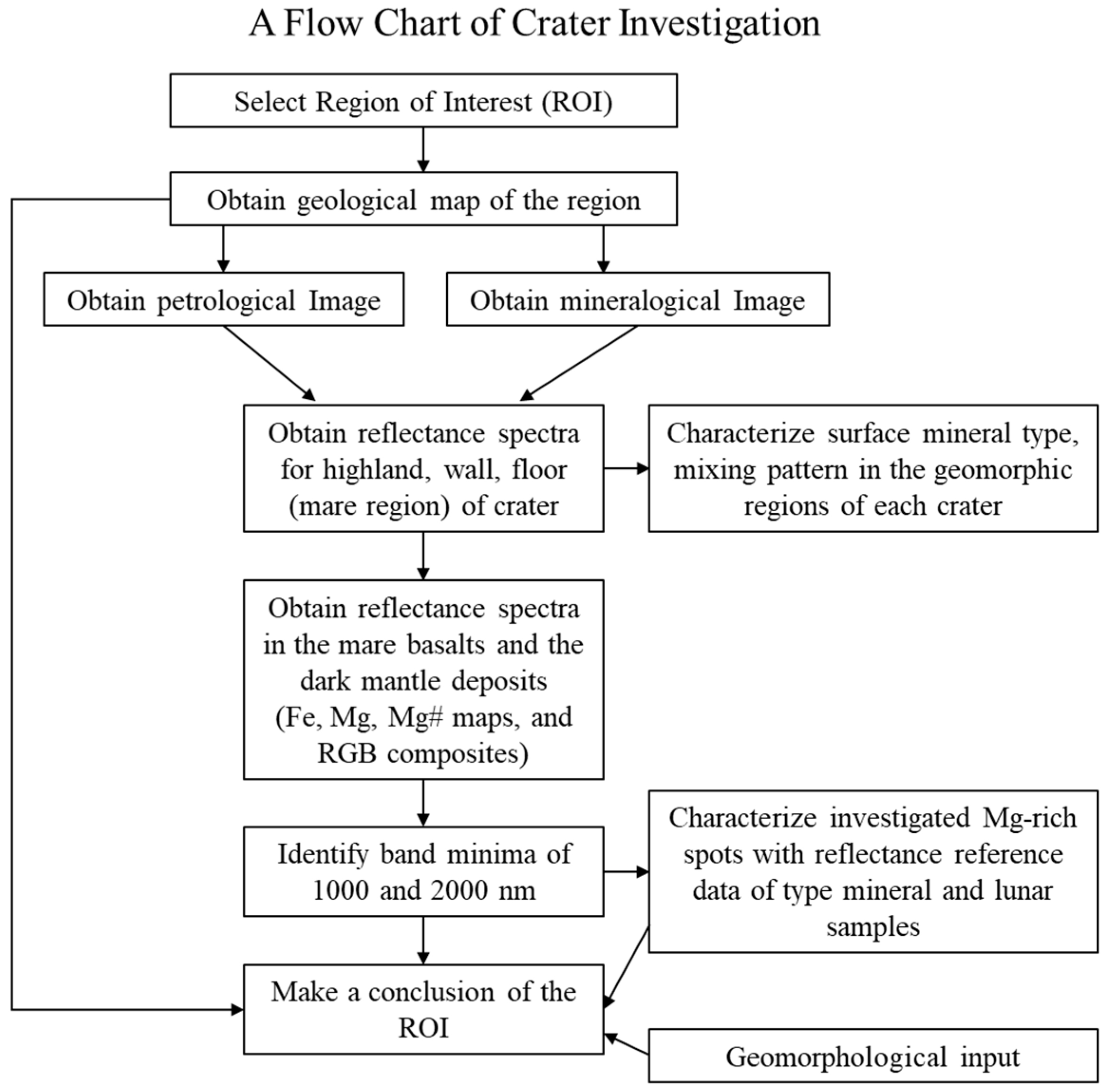
Appendix C
| Name | Region for Each Spectrum | Latitude/Longitude [Degrees] | ||
|---|---|---|---|---|
| Study area | Lavoisier and Lavoisier F | Highland materials | H1 | 36.3067°N/82.6820°W |
| H2 | 37.0094°N/82.7743°W | |||
| H3 | 38.9682°N/82.9289°W | |||
| Mare basalts | M1 | 38.1299°N/82.0146°W | ||
| M2 | 36.9125°N/81.3164°W | |||
| M3 | 36.9015°N/81.30512°W | |||
| M4 | 38.0384°N/82.5047°W | |||
| M5 | 39.0097°N/81.6745°W | |||
| M6 | 38.9454°N/81.9143°W | |||
| M7 | 39.0111°N/81.6631°W | |||
| Crater Floor | cF1 | 38.6637°N/81.1817°W | ||
| cF2 | 38.6041°N/81.0351°W | |||
| cF3 | 38.5228°N/80.8295°W | |||
| cF4 | 37.8880°N/80.6369°W | |||
| cF5 | 37.1337°N/80.5528°W | |||
| cF6 | 36.8896°N/80.4605°W | |||
| cF7 | 38.0238°N/80.9476°W | |||
| cF8 | 38.2273°N/81.2216°W | |||
| cF9 | 38.3846°N/81.4631°W | |||
| cF10 | 38.2408°N/81.6856°W | |||
| cF11 | 37.8284°N/81.6612°W | |||
| Lavoisier E | Highland materials | H1 | 41.6304°N/79.4765°W | |
| H2 | 40.3471°N/79.4602°W | |||
| H3 | 40.1843°N/81.4272°W | |||
| Crater wall | C1 | 40.9684°N/79.3436°W | ||
| C2 | 41.5571°N/79.8536°W | |||
| C3 | 41.7049°N/80.5287°W | |||
| Mare basalts | M1 | 41.0552°N/80.2470°W | ||
| M2 | 41.1095°N/79.9622°W | |||
| M3 | 40.8397°N/80.1726°W | |||
| M4 | 40.8352°N/80.2620°W | |||
| M5 | 40.7622°N/80.7083°W | |||
| M6 | 40.8464°N/80.9971°W | |||
| M7 | 41.1749°N/81.1021°W | |||
| M8 | 41.3425°N/80.5256°W | |||
| Lavoisier H | Highland materials | H1 | 37.8240°N/79.5333°W | |
| H2 | 37.9852°N/79.6296°W | |||
| H3 | 38.1810°N/79.6552°W | |||
| H4 | 38.6825°N/79.5182°W | |||
| Crater wall | C1 | 38.3365°N/78.3691°W | ||
| C2 | 38.0533°N/78.3796°W | |||
| C3 | 37.9690°N/78.3736°W | |||
| Mare Basalts | M1 | 38.5289°N/79.0302°W | ||
| M2 | 37.8903°N/79.1944°W | |||
| M3 | 38.0981°N/79.3977°W | |||
| M4 | 38.55877°N/78. 9105°W | |||
| Dark mantle deposits | D1 | 38.2462°N/78.7930°W | ||
| D2 | 38.3502°N/78.8171°W | |||
| D3 | 38.3577°N/78.6680°W | |||
| D4 | 38.2598°N/78.5837°W | |||
| D5 | 38.1664°N/78.7087°W | |||
| D6 | 38.0414°N/79.0024°W | |||
| D7 | 38.2462°N/79.2704°W | |||
| D8 | 38.5008°N/78.8457°W | |||
| Lavoisier C | Crater wall | C1 | 35.2459°N/76.8265°W | |
| C2 | 35.5423°N/77.2355°W | |||
| C3 | 35.8134°N/77.3369°W | |||
| C4 | 35.9703°N/77.2830°W | |||
| C5 | 36.1606°N/77.1356°W | |||
| Mare Basalts | M1 | 36.3003°N/76.2107°W | ||
| M2 | 35.3137°N/76.1647°W | |||
| M3 | 35.9656°N/76.2796°W | |||
| M4 | 35.7183°N/76.2811°W | |||
| M5 | 35.4900°N/76.5998°W | |||
| M6 | 35.5788°N/76.9549°W | |||
| M7 | 35.7991°N/76.9295°W | |||
| M8 | 35.9164°N/76.5982°W | |||
Appendix D
| Geologic Units * in Figure 1 | Clinopyroxene | Orthopyroxene (Shifted by Ca) in the Norite | ||
|---|---|---|---|---|
| Subcalcic Augite | Pigeonite | |||
| Lavoisier | pNc, Nc, Ip | cF4, cF11 | cF1, cF2, cF4, cF8, cF11 | cF1, cF8 |
| Lavoisier F | pNc, Nc, Ip | cF5, cF6 | cF5, cF6 | |
| Lavoisier E | NC, Im2 | M3, M4, M5, M6, M7, M8 (Figure 6) | ||
| Lavoisier H | pNc | D3 | D2, D3, D6, D7, D8, D1 (Figure 7), D4 (Figure 7) | D2, D7, D8 |
| Lavoisier C | Nc, Im2 | M4, M5, M8 | ||
| Region/Minimum Points | Absorption Feature (nm) (Near 1000) | Absorption Feature (Band Point) (Value) | Absorption Feature (nm) (Near 2000) | Absorption Feature (Band Point) (Value) |
|---|---|---|---|---|
| Lav cF1 | 930.1 | 0.879 | 2018.0 | 0.793 |
| Lav cF2 | 950.0 | 0.917 | 2057.9 | 0.873 |
| Lav cF4 | 970.0 | 0.927 | 2097.8 | 0.885 |
| Lav cF8 | 930.1 | 0.880 | 2018.0 | 0.843 |
| Lav cF11 | 930.1 | 0.908 | 2137.8 | 0.876 |
| Lav F cF5 | 970.0 | 0.916 | 2018.0 | 0.887 |
| Lav F cF6 | 950.0 | 0.820 | 2057.9 | 0.775 |
| Lav E M3 | 1029.9 | 0.877 | 2257.5 | 0.865 |
| Lav E M4 | 989.9 | 0.817 | 2137.8 | 0.820 |
| Lav E M5 | 989.9 | 0.782 | 2177.7 | 0.786 |
| Lav E M6 | 989.9 | 0.880 | 2297.4 | 0.873 |
| Lav E M7 | 989.9 | 0.892 | 2257.5 | 0.881 |
| Lav H D2 | 910.1 | 0.922 | 2018.0 | 0.882 |
| Lav H D3 | 970.0 | 0.913 | 2057.9 | 0.900 |
| Lav H D6 | 930.1 | 0.914 | 2057.9 | 0.899 |
| Lav H D7 | 910.1 | 0.882 | 2018.0 | 0.849 |
| Lav H D8 | 910.1 | 0.876 | 2018.0 | 0.848 |
| Lav C M4 | 989.9 | 0.814 | 2057.9 | 0.819 |
| Lav C M5 | 930.1 | 0.842 | 2217.6 | 0.850 |
| Lav C M8 | 1029.9 | 0.837 | 2177.7 | 0.847 |
References
- Wichman, R.W.; Schultz, P.H. Floor-fractured impact craters on Venus: Implications for igneous crater modification and local magmatism. J. Geophys. Res. Earth Surf. 1995, 100, 3233–3244. [Google Scholar] [CrossRef]
- Schultz, P.H.; Orphal, D.L. Floor-fractured craters on the Moon and Mars. Meteoritics 1978, 13, 622–625. [Google Scholar]
- Buczkowski, D.; Williams, D.; Scully, J.; Mest, S.; Crown, D.; Schenk, P.; Jaumann, R.; Roatsch, T.; Preusker, F.; Nathues, A.; et al. The geology of the occator quadrangle of dwarf planet Ceres: Floor-fractured craters and other geomorphic evidence of cryomagmatism. Icarus 2018, 316, 128–139. [Google Scholar] [CrossRef]
- Schultz, P.H. Floor-fractured lunar craters. Earth Moon Planets 1976, 15, 241–273. [Google Scholar] [CrossRef]
- Masursky, H. A Preliminary Report on the Role of Isostatic Rebound in the Geologic Development of the Lunar Crater Ptolemaeus. In Astrogeologic Studies; United States Geological Survey: Reston, VA, USA, 1964; pp. 102–134. [Google Scholar]
- Daneš, Z.F. Rebound Processes in Large Craters. In Astrogeologic Studies; United States Geological Survey: Reston, VA, USA, 1965; pp. 81–100. [Google Scholar]
- Jozwiak, L.M.; Head, J.W.; Zuber, M.T.; Smith, D.E.; Neumann, G. Lunar floor-fractured craters: Classification, distribution, origin and implications for magmatism and shallow crustal structure. J. Geophys. Res. Earth Surf. 2012, 117, E11005. [Google Scholar] [CrossRef]
- Jozwiak, L.M.; Head, J.W.; Wilson, L. Lunar floor-fractured craters as magmatic intrusions: Geometry, modes of emplacement, associated tectonic and volcanic features, and implications for gravity anomalies. Icarus 2015, 248, 424–447. [Google Scholar] [CrossRef]
- Wilson, L.; Head, J.W. Lunar floor-fractured craters: Modes of dike and sill emplacement and implications of gas production and intrusion cooling on surface morphology and structure. Icarus 2018, 305, 105–122. [Google Scholar] [CrossRef]
- Taguchi, M.; Morota, T.; Kato, S. Lateral heterogeneity of lunar volcanic activity according to volumes of mare basalts in the farside basins. J. Geophys. Res. Planets 2017, 122, 1505–1521. [Google Scholar] [CrossRef]
- Snyder, G.A.; Taylor, L.A.; Neal, C.R. A chemical model for generating the sources of mare basalts: Combined equilibrium and fractional crystallization of the lunar magmasphere. Geochim. Cosmochim. Acta 1992, 56, 3809–3823. [Google Scholar] [CrossRef]
- Elkins-Tanton, L.T.; Burgess, S.; Yin, Q.-Z. The lunar magma ocean: Reconciling the solidification process with lunar petrology and geochronology. Earth Planet. Sci. Lett. 2011, 304, 326–336. [Google Scholar] [CrossRef]
- Elardo, S.M.; Draper, D.S.; Shearer, C.K., Jr. Lunar Magma Ocean crystallization revisited: Bulk composition, early cumulate mineralogy, and the source regions of the highlands Mg-suite. Geochim. Cosmochim. Acta 2011, 75, 3024–3045. [Google Scholar] [CrossRef]
- Moriarty, D.P.; Dygert, N.; Valencia, S.N.; Watkins, R.N.; Petro, N.E. The search for lunar mantle rocks exposed on the surface of the Moon. Nat. Commun. 2021, 12, 4659. [Google Scholar] [CrossRef] [PubMed]
- Nakamura, R.; Yamamoto, S.; Matsunaga, T.; Ishihara, Y.; Morota, T.; Hiroi, T.; Takeda, H.; Ogawa, Y.; Yokota, Y.; Hirata, N.; et al. Compositional evidence for an impact origin of the Moon’s Procellarum basin. Nat. Geosci. 2012, 5, 775–778. [Google Scholar] [CrossRef]
- Gaddis, L.R.; Hawke, B.R.; Robinson, M.S.; Coombs, C. Compositional analyses of small lunar pyroclastic deposits using Clementine multispectral data. J. Geophys. Res. Earth Surf. 2000, 105, 4245–4262. [Google Scholar] [CrossRef]
- Gaddis, L.R.; Staid, M.I.; Tyburczy, J.A.; Hawke, B.; Petro, N.E. Compositional analyses of lunar pyroclastic deposits. Icarus 2003, 161, 262–280. [Google Scholar] [CrossRef]
- Gustafson, J.O.; Bell, J.F.; Gaddis, L.R.; Hawke, B.R.; Giguere, T.A. Characterization of previously unidentified lunar pyroclastic deposits using Lunar Reconnaissance Orbiter Camera data. J. Geophys. Res. Earth Surf. 2012, 117, E00H25. [Google Scholar] [CrossRef]
- Sivakumar, V.; Neelakantan, R.; Santosh, M. Lunar surface mineralogy using hyperspectral data: Implications for primordial crust in the Earth–Moon system. Geosci. Front. 2017, 8, 457–465. [Google Scholar] [CrossRef]
- Thorey, C.; Michaut, C. A model for the dynamics of crater-centered intrusion: Application to lunar floor-fractured craters. J. Geophys. Res. Planets 2014, 119, 286–312. [Google Scholar] [CrossRef]
- Johnson, T.; Morrissey, L.; Nemchin, A.; Gardiner, N.; Snape, J. The phases of the Moon: Modelling crystallisation of the lunar magma ocean through equilibrium thermodynamics. Earth Planet. Sci. Lett. 2020, 556, 116721. [Google Scholar] [CrossRef]
- Rencz, A.N.; Ryerson, R.A. (Eds.) Manual of Remote Sensing, Remote Sensing for the Earth Sciences; John Wiley & Sons: Hoboken, NJ, USA, 1999; Volume 3. [Google Scholar]
- Stuart, B.H. Infrared Spectroscopy: Fundamentals and Applications; John Wiley and Sons Ltd.: Chichester, UK, 2004; ISBN 0470854278. [Google Scholar]
- Heiken, G.H.; Vaniman, D.T.; French, B.M. Lunar Rocks. In Lunar Sourcebook-A User’s Guide to the Moon; Cambridge University Press: Cambridge, UK, 1991; Chapter 6; pp. 183–284. [Google Scholar]
- Morimoto, N.; Fabries, J.; Ferguson, A. Nomenclature of pyroxenes. Mineral. J. 1989, 14, 198–221. [Google Scholar] [CrossRef]
- Wieczorek, M.A.; Jolliff, B.L.; Khan, A.; Pritchard, M.E.; Weiss, B.P.; Williams, J.G.; Hood, L.L.; Righter, K.; Neal, C.R.; Bussey, B.; et al. The constitution and structure of the lunar interior. Rev. Mineral. Geochem. 2006, 60, 221–364. [Google Scholar]
- Berezhnoy, A.; Hasebe, N.; Kobayashi, M.; Michael, G.; Okudaira, O.; Yamashita, N. A three end-member model for petrologic analysis of lunar prospector gamma-ray spectrometer data. Planet. Space Sci. 2005, 53, 1097–1108. [Google Scholar] [CrossRef]
- Wöhler, C.; Grumpe, A.; Berezhnoy, A.; Bhatt, M.U.; Mall, U. Integrated topographic, photometric and spectral analysis of the lunar surface: Application to impact melt flows and ponds. Icarus 2014, 235, 86–122. [Google Scholar] [CrossRef]
- Bhatt, M.; Wöhler, C.; Dhingra, D.; Thangjam, G.; Rommel, D.; Mall, U.; Bhardwaj, A.; Grumpe, A. Compositional studies of Mare Moscoviense: New perspectives from Chandrayaan-1 VIS-NIR data. Icarus 2018, 303, 149–165. [Google Scholar] [CrossRef]
- Fortezzo, C.M.; Spudis, P.D.; Harrel, S.L. Release of the digital unified global geologic map of the Moon at 1:5,000,000-Scale. In Proceedings of the Lunar and Planetary Science Conference, No. 2326, The Woodlands, TX, USA, 16–20 March 2020. [Google Scholar]
- Wilhelms, D.E.; McCauley, J.F.; Trask, N.J. The Geologic History of the Moon; USGS Professional Paper 1348: For Sale by the Books and Open-File Reports Section; US Geological Survey: Menlo Park, CA, USA, 1987.
- Besse, S.; Sunshine, J.M.; Gaddis, L.R. Volcanic glass signatures in spectroscopic survey of newly proposed lunar pyroclastic deposits. J. Geophys. Res. Planets 2014, 119, 355–372. [Google Scholar] [CrossRef]
- Kumaresan, P.; Saravanavel, J.; Palanivel, K. Lithological mapping of Eratosthenes crater region using Moon Mineralogy Mapper of Chandrayaan-1. Planet. Space Sci. 2020, 182, 104817. [Google Scholar] [CrossRef]
- Wöhler, C.; Grumpe, A.; Berezhnoy, A.A.; Feoktistova, E.; Evdokimova, N.A.; Kapoor, K.; Shevchenko, V.V. Temperature regime and water/hydroxyl behavior in the crater Boguslawsky on the Moon. Icarus 2017, 285, 118–136. [Google Scholar] [CrossRef]
- Wöhler, C.; Grumpe, A.; Berezhnoy, A.A.; Shevchenko, V.V. Time-of-day–dependent global distribution of lunar surficial water/hydroxyl. Sci. Adv. 2017, 3, e1701286. [Google Scholar] [CrossRef]
- Bhatt, M.; Wöhler, C.; Grumpe, A.; Hasebe, N.; Naito, M. Global mapping of lunar refractory elements: Multivariate regression vs. machine learning. Astron. Astrophys. 2019, 627, A155. [Google Scholar] [CrossRef]
- Pieters, C.M.; Boardman, J.; Buratti, B.; Chatterjee, A.; Clark, R.; Glavich, T.; Green, R.; Head, J.; Isaacson, P.; White, M.; et al. The Moon Mineralogy Mapper (M3) on Chandrayaan-1. Curr. Sci. 2009, 96, 500–505. [Google Scholar]
- Bhatt, M.; Mall, U.; Wöhler, C.; Grumpe, A.; Bugiolacchi, R. A comparative study of iron abundance estimation methods: Application to the western nearside of the Moon. Icarus 2015, 248, 72–88. [Google Scholar] [CrossRef]
- Lawrence, D.J.; Feldman, W.C.; Barraclough, B.L.; Binder, A.B.; Elphic, R.C.; Maurice, S.; Thomsen, D.R. Global Elemental Maps of the Moon: The Lunar Prospector Gamma-Ray Spectrometer. Science 1998, 281, 1484–1489. [Google Scholar] [CrossRef] [PubMed]
- Prettyman, T.H.; Hagerty, J.J.; Elphic, R.C.; Feldman, W.C.; Lawrence, D.J.; McKinney, G.W.; Vaniman, D.T. Elemental composition of the lunar surface: Analysis of gamma ray spectroscopy data from Lunar Prospector. J. Geophys. Res. Earth Surf. 2006, 111, E12007. [Google Scholar] [CrossRef]
- Elphic, R.C.; Lawrence, D.J.; Feldman, W.C.; Barraclough, B.L.; Maurice, S.; Binder, A.B.; Lucey, P.G. Lunar rare earth element distribution and ramifications for FeO and TiO2: Lunar Prospector neutron spectrometer observations. J. Geophys. Res. Earth Surf. 2000, 105, 20333–20345. [Google Scholar] [CrossRef]
- Heiken, G.H.; Vaniman, D.T.; French, B.M. Lunar Chemistry. In Lunar Sourcebook, a User’s Guide to the Moon; Cambridge University Press: Cambridge, UK, 1991; Chapter 8; pp. 357–474. [Google Scholar]
- Grumpe, A.; Belkhir, F.; Wöhler, C. Construction of lunar DEMs based on reflectance modelling. Adv. Space Res. 2014, 53, 1735–1767. [Google Scholar] [CrossRef]
- Scholten, F.; Oberst, J.; Matz, K.-D.; Roatsch, T.; Wahlisch, M.; Speyerer, E.; Robinson, M.S. GLD100: The near-global lunar 100 m raster DTM from LROC WAC stereo image data. J. Geophys. Res. Earth Surf. 2012, 117, E00H17. [Google Scholar] [CrossRef]
- Hapke, B. Bidirectional reflectance spectroscopy: 3. Correction for macroscopic roughness. Icarus 1984, 59, 41–59. [Google Scholar] [CrossRef]
- Hapke, B. Bidirectional Reflectance Spectroscopy: 5. The Coherent Backscatter Opposition Effect and Anisotropic Scattering. Icarus 2002, 157, 523–534. [Google Scholar] [CrossRef]
- Wöhler, C.; Berezhnoy, A.; Evans, R. Estimation of elemental abundances of the lunar regolith using clementine UVVIS+NIR data. Planet. Space Sci. 2011, 59, 92–110. [Google Scholar] [CrossRef]
- Öhman, T.; Kramer, G.Y.; Kring, D.A. Characterization of melt and ejecta deposits of Kepler crater from remote sensing data. J. Geophys. Res. Planets 2014, 119, 1238–1258. [Google Scholar] [CrossRef]
- Grumpe, A.; Wöhler, C.; Berezhnoy, A.A.; Shevchenko, V.V. Time-of-day-dependent behavior of surficial lunar hydroxyl/water: Observations and modeling. Icarus 2018, 321, 486–507. [Google Scholar] [CrossRef]
- Staid, M.I.; Pieters, C.M.; Besse, S.; Boardman, J.; Dhingra, D.; Green, R.; Head, J.W.; Isaacson, P.; Klima, R.; Kramer, G.; et al. The mineralogy of late stage lunar volcanism as observed by the Moon Mineralogy Mapper on Chandrayaan-1. J. Geophys. Res. Earth Surf. 2011, 116, E00G10. [Google Scholar] [CrossRef]
- Clark, R.N.; Swayze, G.A.; Livo, K.E.; Kokaly, R.F.; Sutley, S.J.; Dalton, J.B.; McDougal, R.R.; Gent, C.A. Imaging spectroscopy: Earth and planetary remote sensing with the USGS Tetracorder and expert systems. J. Geophys. Res. Planet 2003, 108, 5131. [Google Scholar] [CrossRef]
- Adams, J.B. Visible and near-infrared diffuse reflectance spectra of pyroxenes as applied to remote sensing of solid objects in the solar system. J. Geophys. Res. Earth Surf. 1974, 79, 4829–4836. [Google Scholar] [CrossRef]
- Pieters, C.M.; Hanna, K.D.; Cheek, L.; Dhingra, D.; Prissel, T.; Jackson, C.; Moriarty, D.; Parman, S.; Taylor, L.A. The distribution of Mg-spinel across the Moon and constraints on crustal origin. Am. Miner. 2014, 99, 1893–1910. [Google Scholar] [CrossRef]
- Barker, M.; Mazarico, E.; Neumann, G.; Zuber, M.; Haruyama, J.; Smith, D. A new lunar digital elevation model from the Lunar Orbiter Laser Altimeter and SELENE Terrain Camera. Icarus 2015, 273, 346–355. [Google Scholar] [CrossRef]
- Xia, W.; Wang, X.; Zhao, S.; Jin, H.; Chen, X.; Yang, M.; Wu, X.; Hu, C.; Zhang, Y.; Shi, Y.; et al. New maps of lunar surface chemistry. Icarus 2018, 321, 200–215. [Google Scholar] [CrossRef]
- Ohtake, M.; Takeda, H.; Matsunaga, T.; Yokota, Y.; Haruyama, J.; Morota, T.; Yamamoto, S.; Ogawa, Y.; Hiroi, T.; Karouji, Y.; et al. Asymmetric crustal growth on the Moon indicated by primitive farside highland materials. Nat. Geosci. 2012, 5, 384–388. [Google Scholar] [CrossRef]
- Souchon, A.; Besse, S.; Pinet, P.; Chevrel, S.; Daydou, Y.; Josset, J.-L.; D’Uston, L.; Haruyama, J. Local spectrophotometric properties of pyroclastic deposits at the Lavoisier lunar crater. Icarus 2013, 225, 1–14. [Google Scholar] [CrossRef]
- Pieters, C.M.; Besse, S.; Boardman, J.; Buratti, B.; Cheek, L.; Clark, R.N.; Combe, J.P.; Dhingra, D.; Goswami, J.N.; Green, R.O.; et al. Mg-spinel lithology: A new rock type on the lunar farside. J. Geophys. Res. Earth Surf. 2011, 116, E00G08. [Google Scholar] [CrossRef]
- Yamamoto, S.; Nakamura, R.; Matsunaga, T.; Ogawa, Y.; Ishihara, Y.; Morota, T.; Hirata, N.; Ohtake, M.; Hiroi, T.; Yokota, Y.; et al. A new type of pyroclastic deposit on the Moon containing Fe-spinel and chromite. Geophys. Res. Lett. 2013, 40, 4549–4554. [Google Scholar] [CrossRef]
- Sivakumar, V.; Neelakantan, R. Reflectance Imaging Spectroscopy Data (Hyperspectral) for Mineral Mapping in the Orientale Basin Region on the Moon Surface. Int. J. Geol. Environ. Eng. 2016, 10, 303–306. [Google Scholar]
- Thesniya, P.; Rajesh, V. Pyroxene chemistry and crystallization history of basaltic units in the Mare Humorum on the nearside of the Moon: Implications for the volcanic history of the region. Planet. Space Sci. 2020, 193, 105093. [Google Scholar] [CrossRef]
- Ling, Z.; Zhang, J.; Liu, J.; Zhang, W.; Zhang, G.; Liu, B.; Ren, X.; Mu, L.; Liu, J.; Li, C. Preliminary results of TiO2 mapping using Imaging Interferometer data from Chang’E-1. Chin. Sci. Bull. 2011, 56, 2082–2087. [Google Scholar] [CrossRef][Green Version]
- Lemelin, M.; Morisset, C.-E.; Germain, M.; Hipkin, V.; Goïta, K.; Lucey, P.G. Ilmenite mapping of the lunar regolith over Mare Australe and Mare Ingenii regions: An optimized multisource approach based on Hapke radiative transfer theory. J. Geophys. Res. Planets 2013, 118, 2582–2593. [Google Scholar] [CrossRef]
- He, Z.P.; Wang, B.Y.; Lv, G.; Li, C.L.; Yuan, L.Y.; Xu, R.; Chen, K.; Wang, J.Y. Visible and near-infrared imaging spectrometer and its preliminary results from the Chang’E 3 project. Rev. Sci. Instrum. 2014, 85, 083104. [Google Scholar] [CrossRef]
- Coombs, C.R.; Hawke, B.R.; Robinson, M.S. Pyroclastic deposits on the northwestern limb of the Moon. In Proceedings of the Lunar and Planetary Science Conference, Houston, TX, USA, 16–20 March 1992; Volume 23. [Google Scholar]
- Head, J.W.; Wilson, L. Rethinking Lunar Mare Basalt Regolith Formation: New Concepts of Lava Flow Protolith and Evolution of Regolith Thickness and Internal Structure. Geophys. Res. Lett. 2020, 47, e2020GL088334. [Google Scholar] [CrossRef]
- Sun, Y.; Li, L.; Zhang, Y. Detection of Mg-spinel bearing central peaks using M 3 images: Implications for the petrogenesis of Mg-spinel. Earth Planet. Sci. Lett. 2017, 465, 48–58. [Google Scholar] [CrossRef]
- Isaacson, P.J.; Pieters, C.M. Northern Imbrium Noritic Anomaly. J. Geophys. Res. Earth Surf. 2009, 114, 09007. [Google Scholar] [CrossRef]
- Spudis, P.D. The Geology of Multi-Ring Impact Basins; Cambridge University Press: Cambridge, UK, 1993. [Google Scholar] [CrossRef]
- Wöhler, C.; Lena, R. Lunar intrusive domes: Morphometric analysis and laccolith modelling. Icarus 2009, 204, 381–398. [Google Scholar] [CrossRef]
- Trang, D.; Gillis-Davis, J.J.; Hawke, B.R. The origin of lunar concentric craters. Icarus 2016, 278, 62–78. [Google Scholar] [CrossRef]
- Liu, T.; Michael, G.; Engelmann, J.; Wünnemann, K.; Oberst, J. Regolith mixing by impacts: Lateral diffusion of basin melt. Icarus 2018, 321, 691–704. [Google Scholar] [CrossRef]

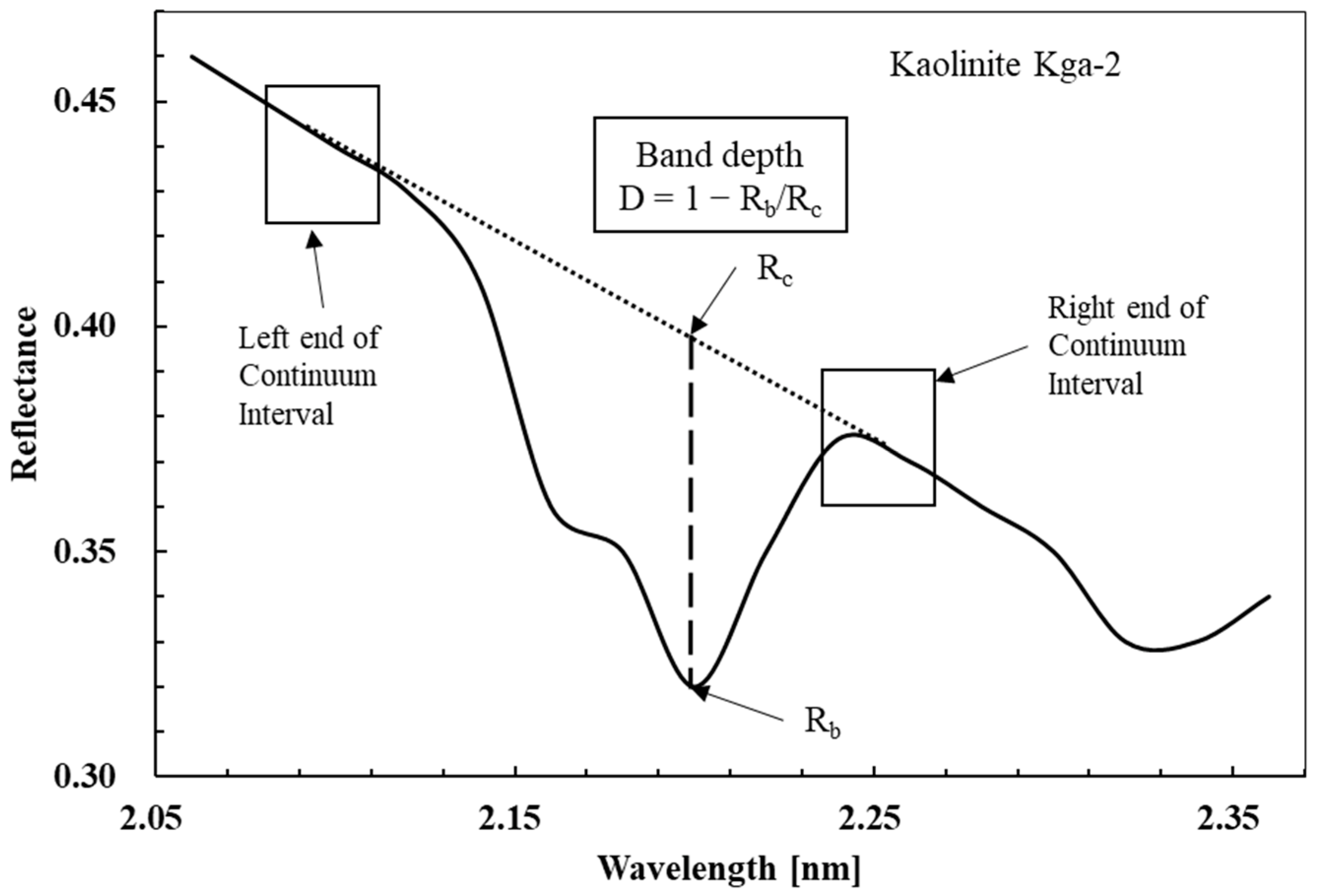
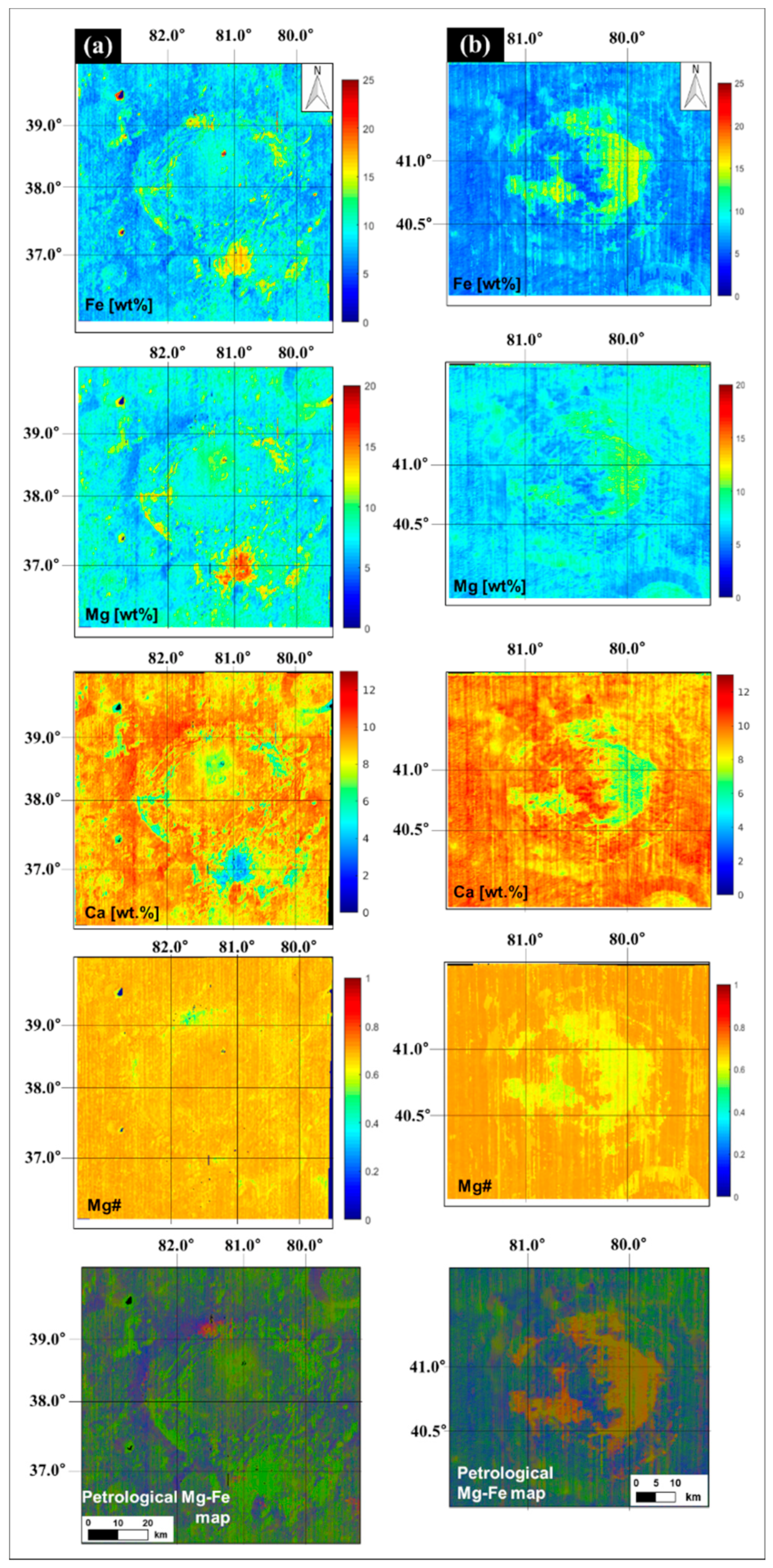
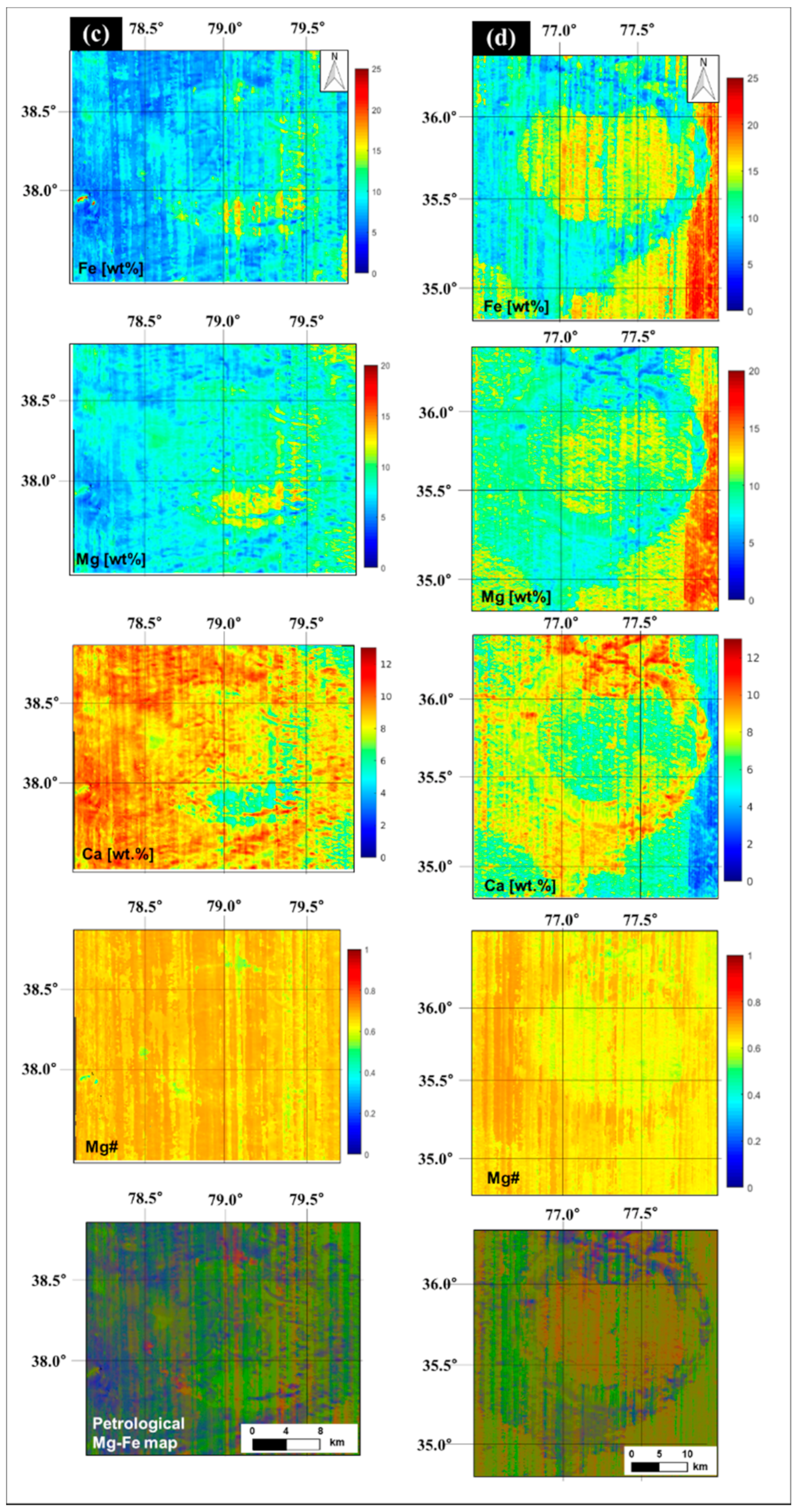
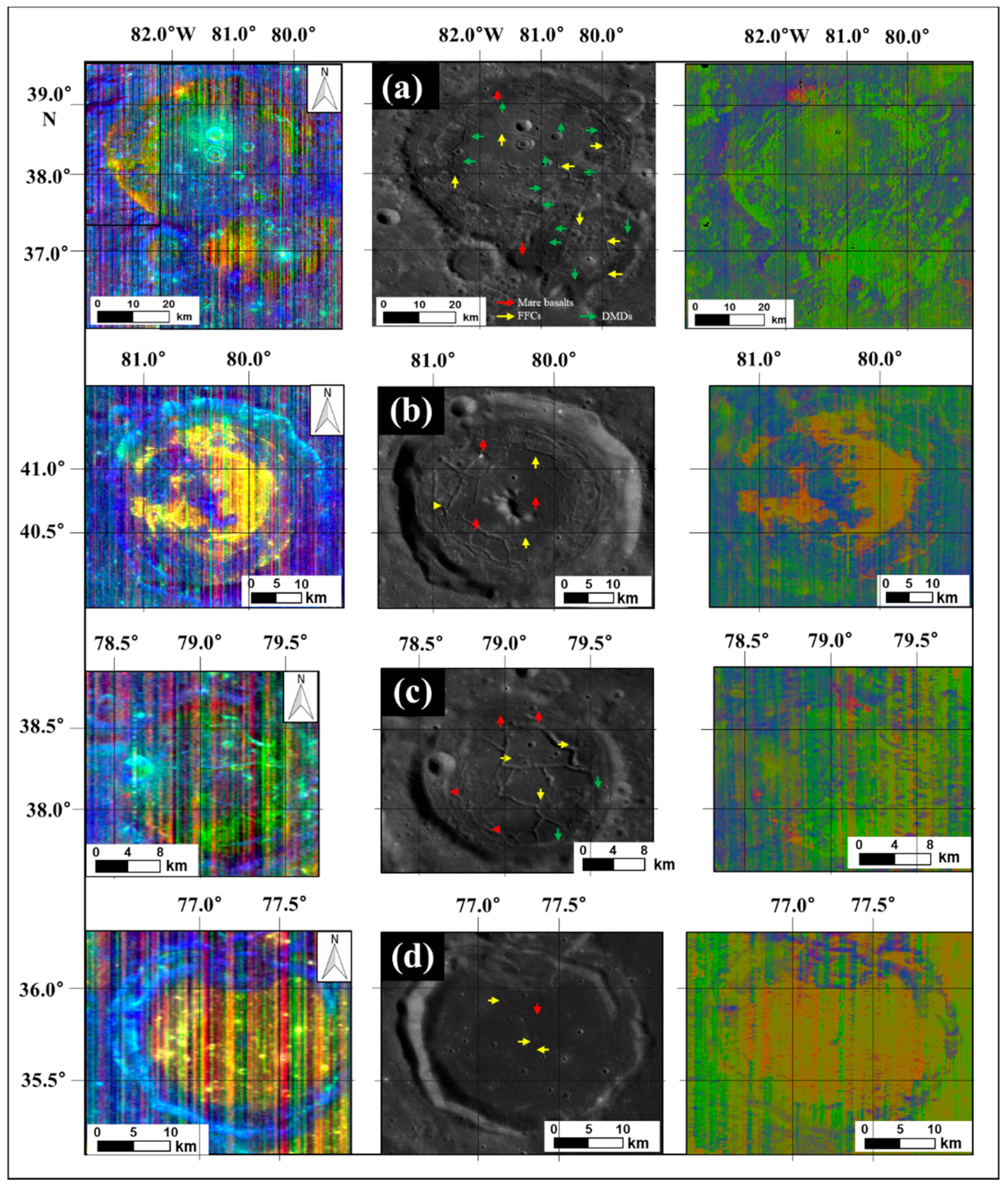
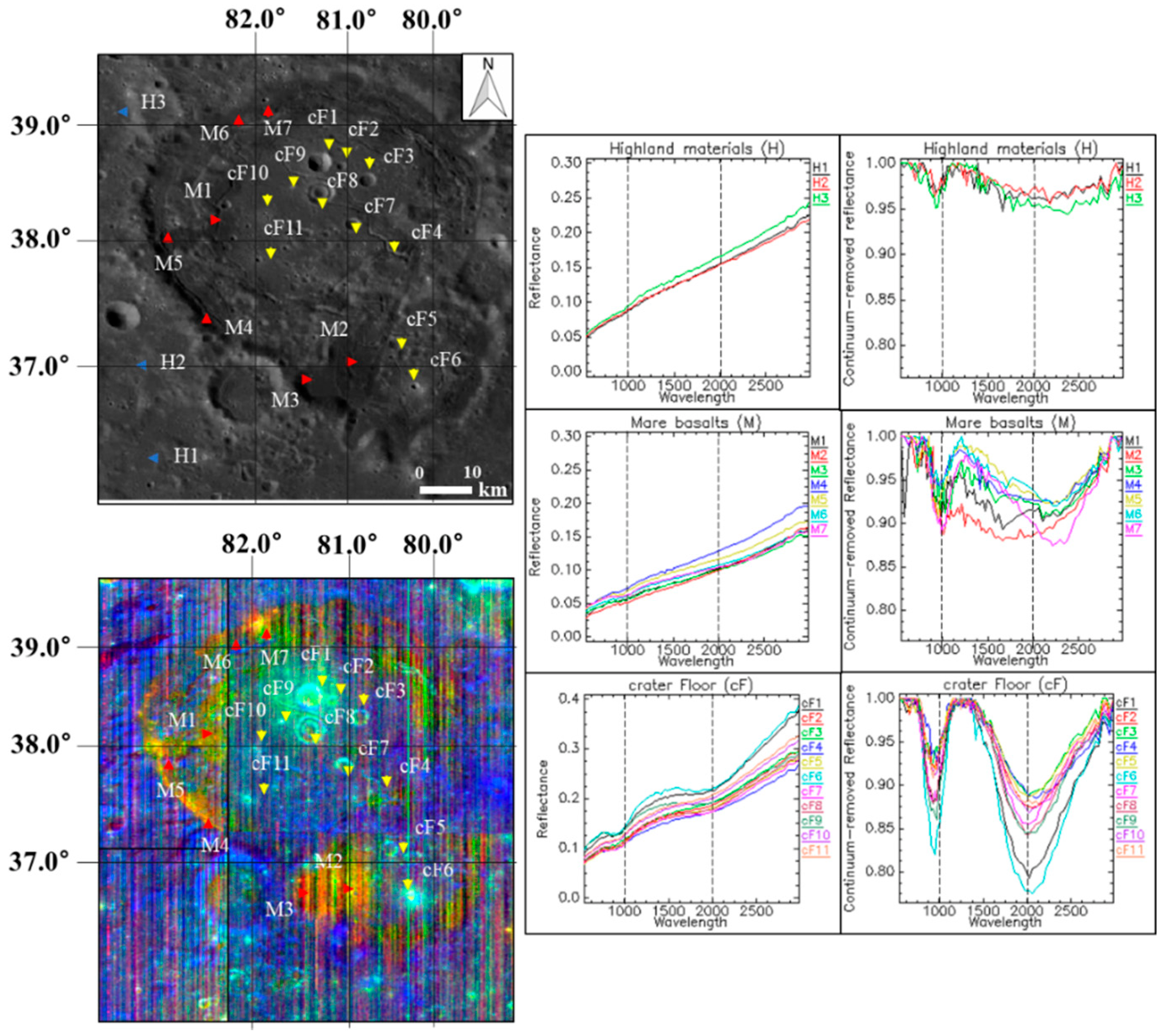
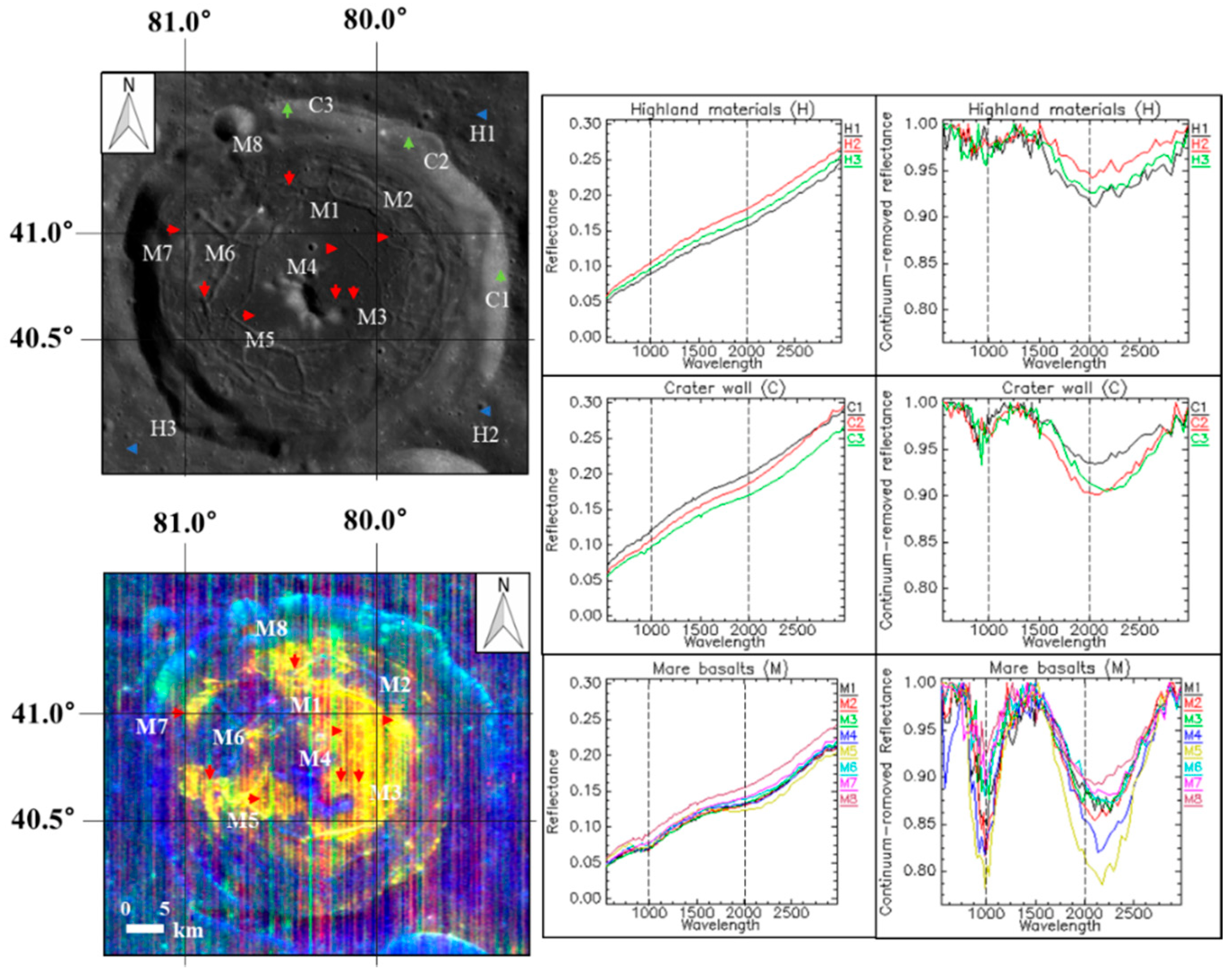
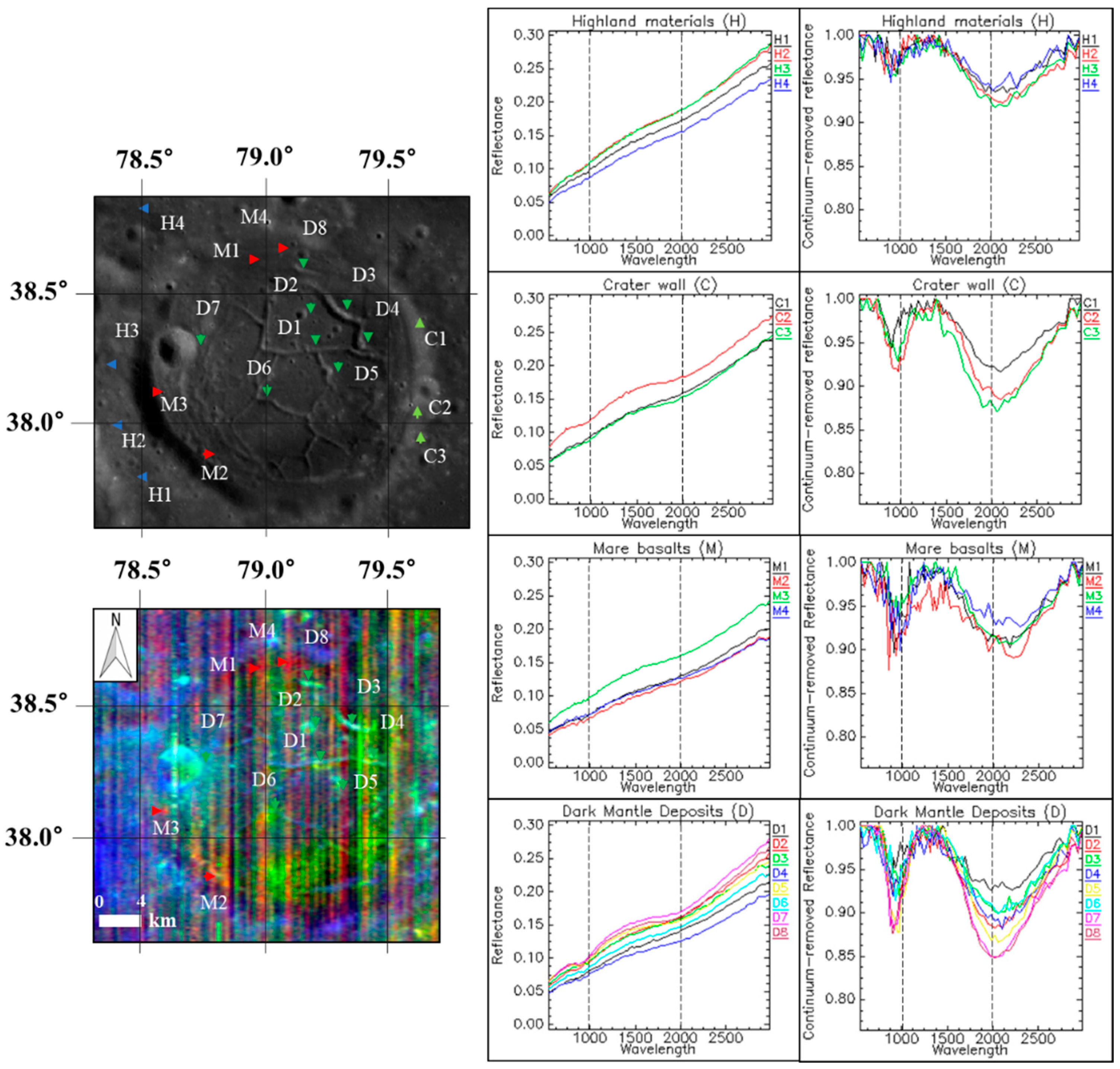
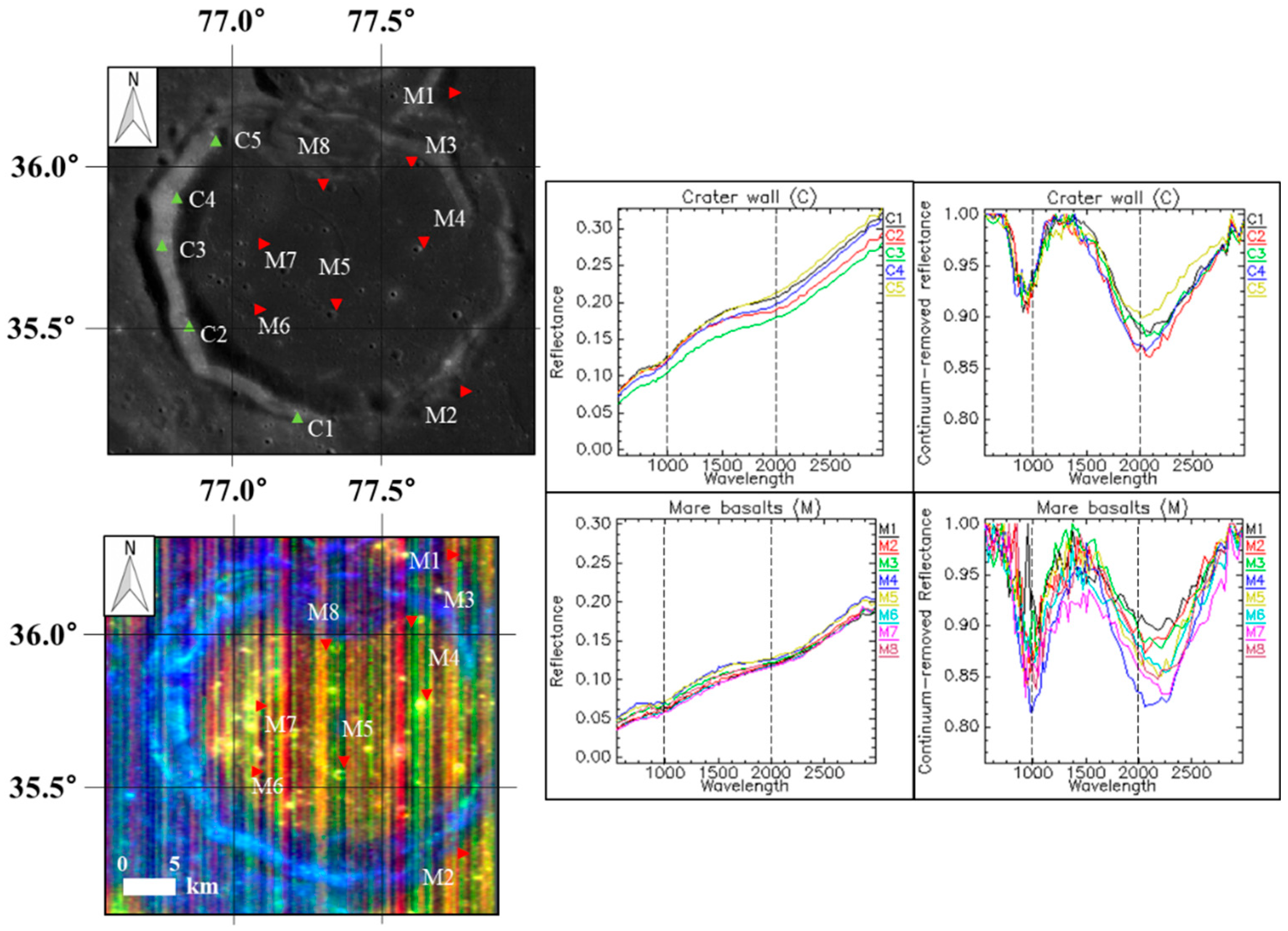
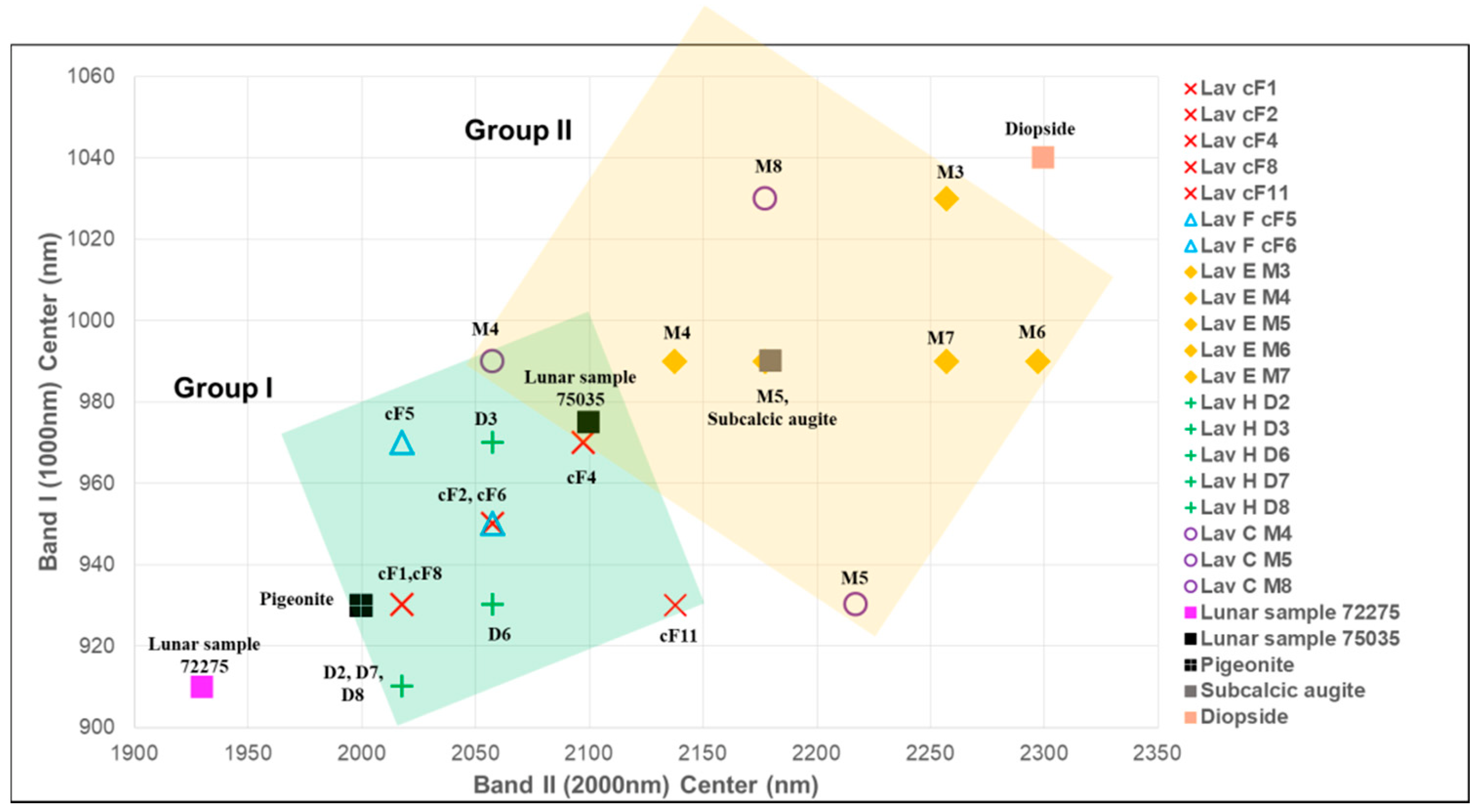
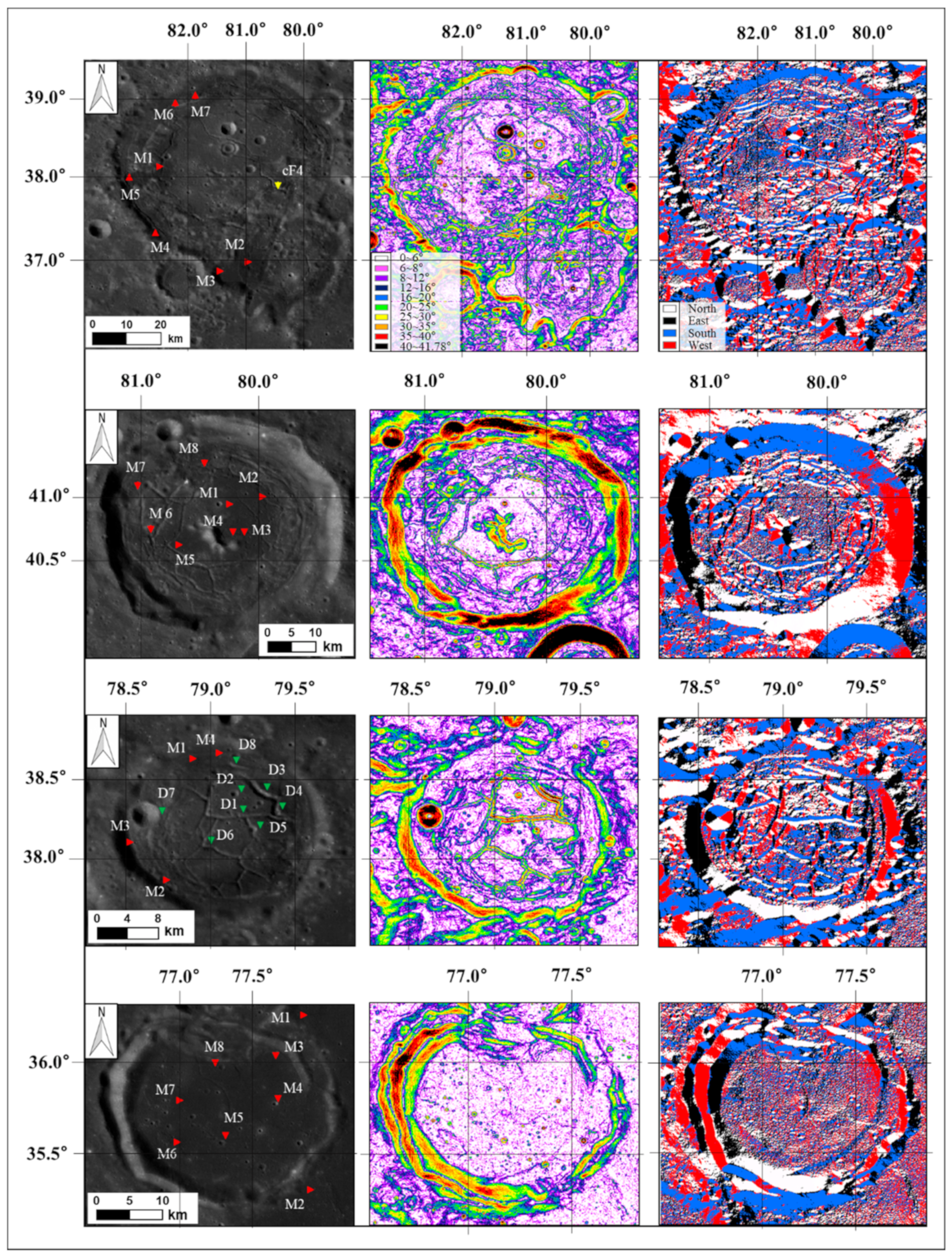
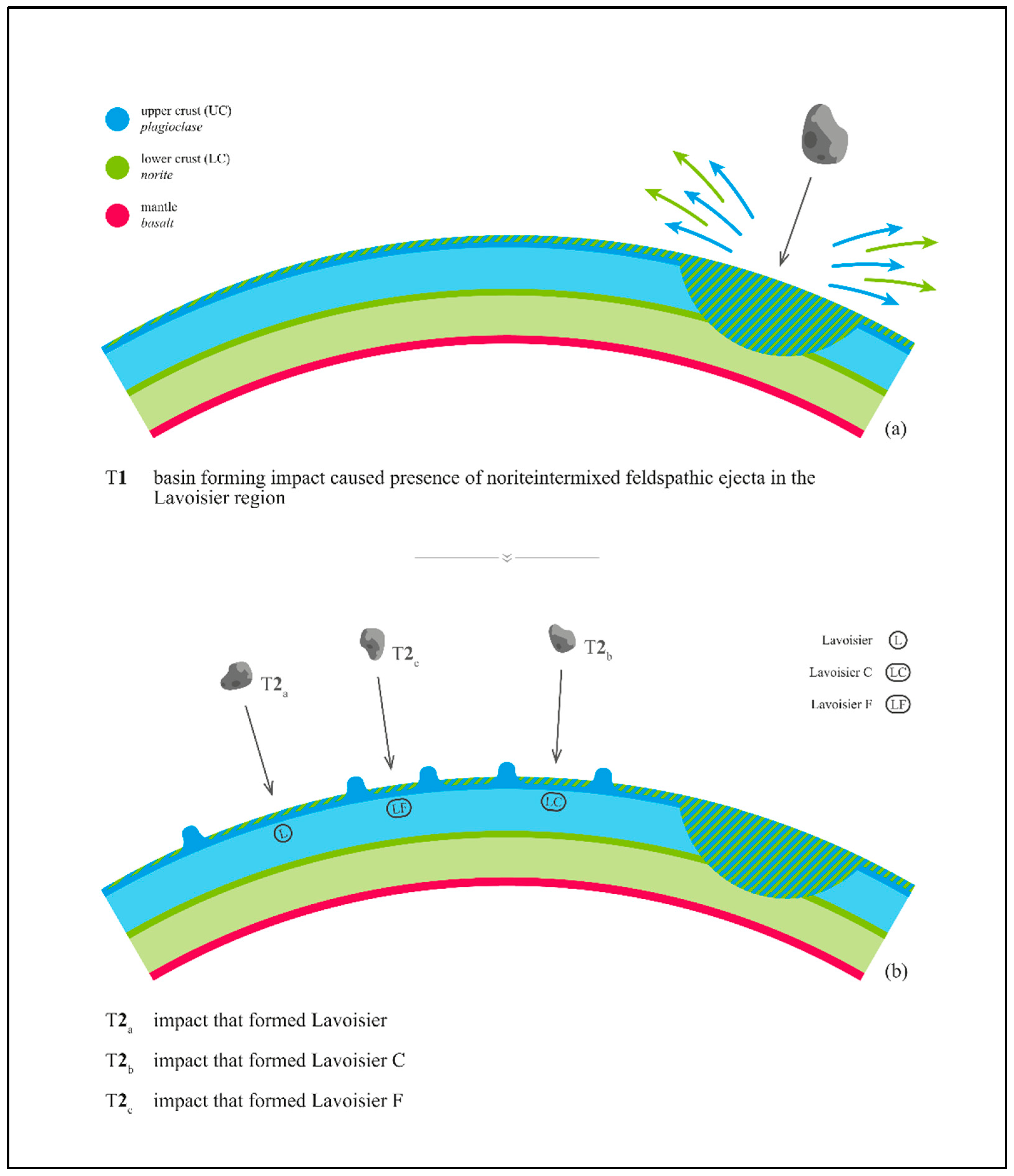
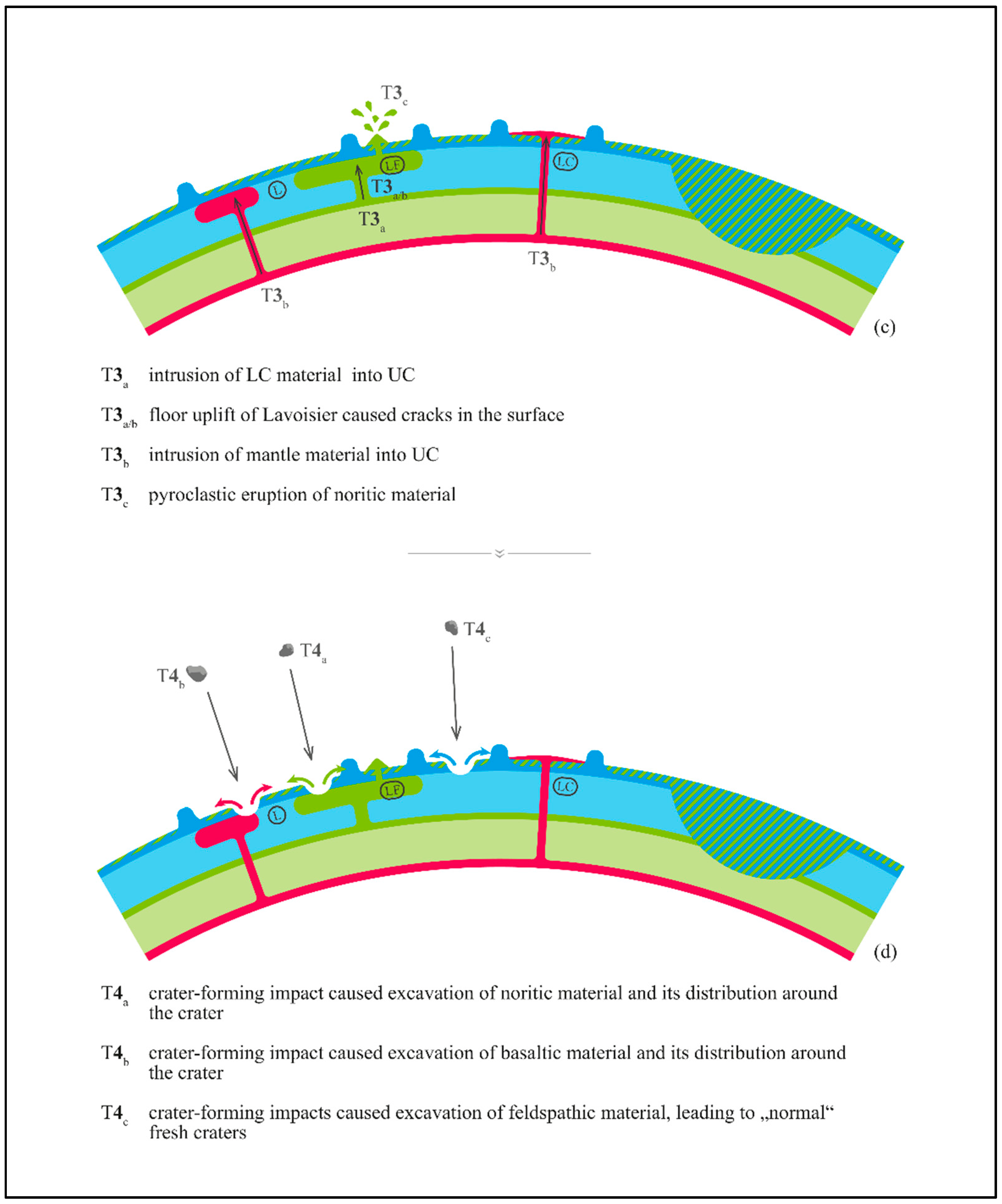
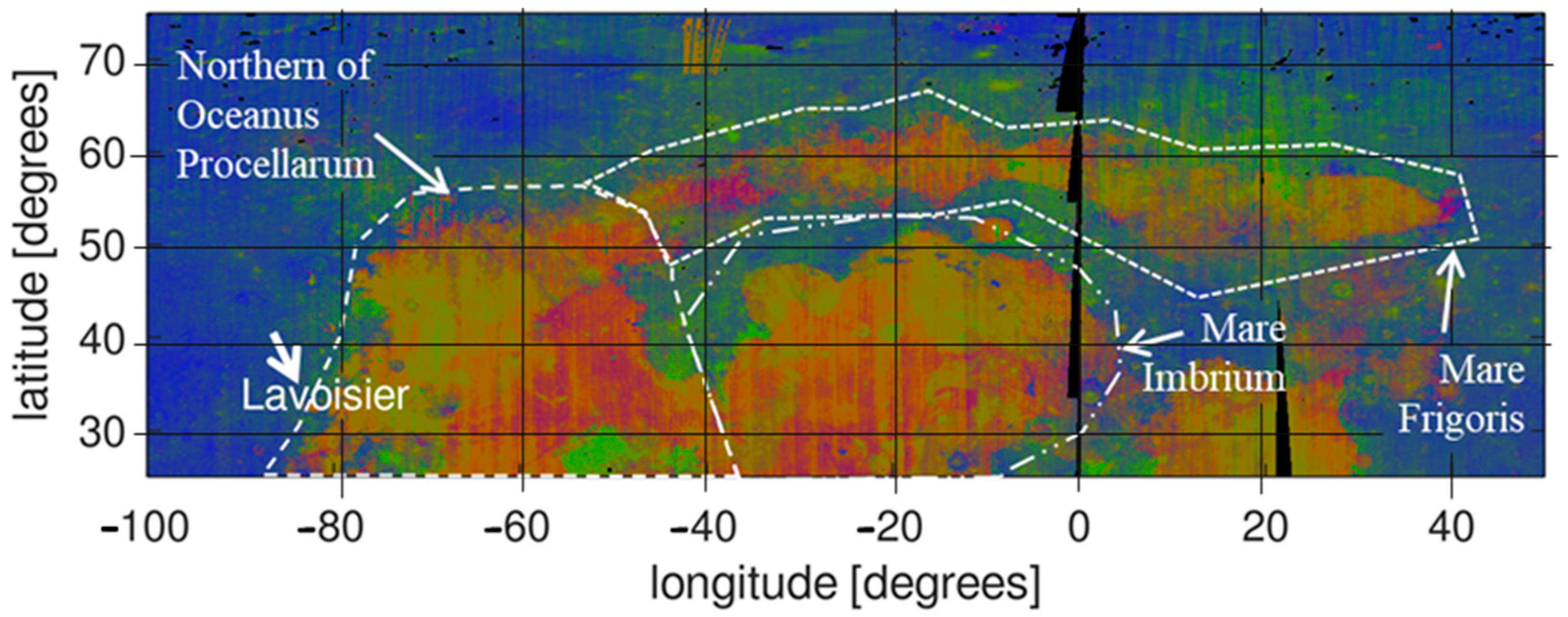
Publisher’s Note: MDPI stays neutral with regard to jurisdictional claims in published maps and institutional affiliations. |
© 2022 by the authors. Licensee MDPI, Basel, Switzerland. This article is an open access article distributed under the terms and conditions of the Creative Commons Attribution (CC BY) license (https://creativecommons.org/licenses/by/4.0/).
Share and Cite
Yi, E.S.; Kim, K.J.; Wöhler, C.; Berezhnoy, A.A.; Kim, Y.H.; Moon, S. Petrological and Mineralogical Characteristics of Exposed Materials on the Floors of the Lavoisier and Surrounding Craters. Remote Sens. 2022, 14, 4313. https://doi.org/10.3390/rs14174313
Yi ES, Kim KJ, Wöhler C, Berezhnoy AA, Kim YH, Moon S. Petrological and Mineralogical Characteristics of Exposed Materials on the Floors of the Lavoisier and Surrounding Craters. Remote Sensing. 2022; 14(17):4313. https://doi.org/10.3390/rs14174313
Chicago/Turabian StyleYi, Eung Seok, Kyeong Ja Kim, Christian Wöhler, Alexey A. Berezhnoy, Yong Ha Kim, and Seulgi Moon. 2022. "Petrological and Mineralogical Characteristics of Exposed Materials on the Floors of the Lavoisier and Surrounding Craters" Remote Sensing 14, no. 17: 4313. https://doi.org/10.3390/rs14174313
APA StyleYi, E. S., Kim, K. J., Wöhler, C., Berezhnoy, A. A., Kim, Y. H., & Moon, S. (2022). Petrological and Mineralogical Characteristics of Exposed Materials on the Floors of the Lavoisier and Surrounding Craters. Remote Sensing, 14(17), 4313. https://doi.org/10.3390/rs14174313






